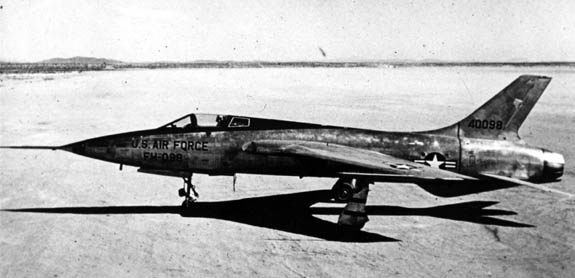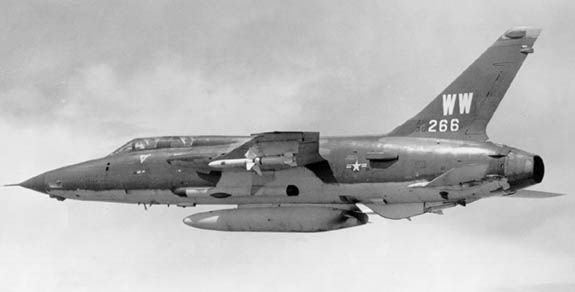WARBIRDS RESOURCE GROUP > VIETNAM > THUD > PREVIOUS PAGE
Design & Development
Traditional fighter attributes such as maneuverability were a secondary consideration. Enthusiastic at first, the United States Air Force awarded Republic with a contract for 199 aircraft in September 1952. However, by March 1953 the USAF had reduced the order to 37 fighter-bombers and 9 tactical reconnaissance aircraft, citing the approaching end of the Korean War. By the time the F-105 mock-up had been completed in October 1953, the aircraft had grown so large that the Allison J71 turbojet intended for it was abandoned in favor of an even more powerful Pratt & Whitney J75. Anticipating protracted development of the engine, it was expected that the first aircraft would use the smaller Pratt & Whitney J57. On 28 June 1954, the USAF officially ordered 15 F-105As under the Weapon System designation WS-306.
The YF-105A prototype first flew on 22 October 1955, with the second YF-105A following on 28 January 1956. In spite of being powered by a less potent J57-P-25 engine with 15,000 pound-force (66.7 kN) of afterburning thrust (the J75 was expected to generate 24,500 pound-force (109.0 kN) with the afterburner), the first prototype attained the speed of Mach 1.2 on its maiden flight. Both prototypes featured conventional wing root air intakes and slab-sided fuselages typical of the early jets. However, insufficient power and aerodynamic problems with transonic drag, as well as Convair's experience with their F-102 Delta Dagger, led to a redesign of the fuselage in order to conform to the Area rule, giving it a characteristic "wasp waist". In combination with the distinctive forward-swept variable-geometry air intakes which regulated airflow to the engine at supersonic speeds and the J75 engine, this enabled the resulting F-105B to attain Mach 2.15.

Republic YF-105A (S/N 54-0098), the first of two prototypes). (U.S. Air Force photo)
The F-105 was a mid-wing monoplane with a 45 degree swept wing and tail surfaces. The single engine was fed by two intakes in the wing roots, leaving the nose free for a radome housing the multi-mode radar. At the time, the F-105 was the largest single-seat combat aircraft ever built. Its capacious fuselage provided room for 1,160 US gallons (4,460 L) of fuel and a bomb bay measuring 15 feet 10 inches by 32 inches by 32 inches (4.82 m x 0.81 m x 0.81 m), originally intended for a single nuclear weapon but typically containing an additional 390 US gallon (1,500 L) fuel tank. Two underwing and one fuselage wet-stores-capable pylons were provided for 450 and 650 US gallon (1,730 L and 2,500 L) expendable fuel tanks. Two outboard (dry) stations were wired for missiles or bombs. A single T-171E3 20 millimeter Gatling cannon was installed in the left side of the nose with a magazine for 1,028 rounds of ammunition, combined with a radar ranging gunsight in B and D models. The aircraft was designed to carry the short-range Sidewinder but it would not be equipped with the medium-range radar-guided missiles.
On 11 December 1959, an F-105B piloted by Brig. Gen. Joseph Moore (commander of the 4th TFW) set a world record of 1,216.48 mph (1,958.53 km/h) over a 100 kilometer (62 mi) circuit. Moore received the Bendix Trophy in 1959 for this feat.
Plans to build over 1,500 F-105Ds were cut short when the Secretary of Defense Robert McNamara decided to equip no more than seven combat wings with the type. Production was cut in favor of the Air Force adopting the Navy's F-4 Phantom II. A total of 833 F-105s were produced before production ended in 1964.
Design
The F-105 was designed primarily for low-level interdiction and its low-altitude speed was its greatest asset when dealing with Soviet Mikoyan-Gurevich MiG-17 and Mikoyan-Gurevich MiG-21 fighters. The Thunderchief's highly loaded wing was excellent for speed and smooth ride but not for sustained turns in a dogfight. Nevertheless, the F-105 managed 27.5 officially credited air-to-air victories against North Vietnamese aircraft at the cost of 17 aircraft lost to enemy fighters (North Vietnamese pilots claimed to have shot down an additional 23 F-105s but none have been confirmed by USAF). All victories were against MiG-17s -- 24.5 were shot down with cannon fire (one victory was shared with an F-4), and three with AIM-9 Sidewinder missiles. F-4 Phantoms were tasked to protect the Thuds from MiG fighters, but they lacked the internal gun and ranging gunsight of the Thunderchief until late in the war.
On the basis of combat experience, the F-105D was updated with a better ejection seat, radar homing and warning (RHAW) antenna on the tail fin, additional armor, and protection to the hydraulic system which proved to be very vulnerable to combat damage. The hot and humid climate of Southeast Asia created problems for the capricious electronics, a problem encountered by virtually all advanced US aircraft of the war. High ambient temperatures also exacerbated the F-105's propensity for engine fires due to inadequate cooling of the afterburner. Most of the Vietnam aircraft were eventually fitted with ram-air scoops to ameliorate this problem.

Republic F-105D-30-RE (S/N 62-4234) in flight with full bomb load.
(U.S. Air Force photo)
Special modifications
The rear cockpits of several two-seat F-105Fs were modified under project Commando Nail with an R-14A radar and a radar scope that offered high resolution. These aircraft were used for all-weather and night low-level strikes against especially dangerous targets by a unit from the 13th Tactical Fighter Squadron dubbed "Ryan's Raiders" starting in April 1967. Commando Nail aircraft were also used to develop tactics for proposed B-58 Hustler bomber missions in Vietnam, although the Hustler was never deployed to Southeast Asia. Some of these aircraft were later converted to the Wild Weasel III standard.

F-105F-1-RE Thunderchief, SN: 63-8339, later converted into a F-105G.
Persistent problems with the AN/ARN-85 LORAN system resulted in 30 F-105Ds being upgraded to the AN/ARN-92 in a long dorsal spine. Known as Thunderstick II aircraft, these F-105s could achieve a bombing circular error probable of 50 feet (15 m) from an altitude of 15,000 feet (4,570 m). Although the first of these aircraft flew in 1969, they were never deployed to Vietnam.
Wild Weasel
In 1965, the USAF began operating two-seat F-100F Super Sabres specially equipped for Suppression of Enemy Air Defenses mission in Vietnam. Nicknamed the Wild Weasel, these aircraft achieved 9 confirmed victories against North Vietnamese surface-to-air missile radars. The second crew member was an Electronic Warfare Officer, nicknamed the Bear(as in trained bear), whose job was to decipher the information from the aircraft's sensors and guide the pilot towards the targets. However, the F-100F was an interim solution and because of its limited payload it usually had to rely on accompanying strike aircraft to actually attack the SAM sites. It also lacked the speed and the endurance to effectively protect the USAF's primary strike fighter — the F-105. With twice the payload capacity of the Super Sabre and considerably better performance, the two-seat F-105F was an ideal candidate for a more definitive SEAD platform.
The resulting EF-105F Wild Weasel III (the EF designation was popularly used but unofficial) supplemented its sensors and electronic jamming equipment with AGM-45 Shrike anti-radiation missiles and conventional bombs, giving it an offensive capability lacking in the F-100F. The first of these aircraft flew on 15 January 1966 and they began arriving in Southeast Asia in June, with five assigned to the 13th TFS at Korat and 6 more to the 354th TFS at Takhli. In a typical early mission, a single EF-105F would accompany one or two flights of F-105Ds to provide protection from enemy ground fire. While this strategy was effective in reducing F-105D losses, the Weasel aircraft suffered heavy casualties with five of the first 11 lost in July and August 1966. Attacks into high-risk environments saw the Weasels operating in "Iron Hand" Hunter-Killer flights of mixed single-seat and two-seat Thunderchiefs, suppressing sites during attacks by the strike force and attacking others during ingress and egress.
The EF-105Fs were upgraded to the definitive Wild Weasel Thunderchief, the F-105G, with the first aircraft arriving in Southeast Asia in late 1967. The genesis of the F-105G was a PACAF policy that all USAF fighter-bombers operating over North Vietnam had to carry ECM pods, which served to degrade the Weasel's own electronics and occupied one ordnance wing hardpoint.
The F-105G incorporated a considerable amount of new SEAD-specific avionics, including an upgraded RHAW system which required a redesign of the wingtips. To free outboard hardpoints for additional weapons, the Westinghouse AN/ALQ-105 electronic countermeasures were permanently installed in two long blisters on the underside of the fuselage. Thirty aircraft were fitted with specially designed pylons to permit carrying of the AGM-78 Standard anti-radiation missile, a considerable improvement over the somewhat lackluster Shrike. On a typical mission, the F-105G carried two Shrikes on outboard pylons, a single Standard on an inboard pylon balanced by a 450 US gallon fuel tank on the other side, and a 650 US gallon centerline fuel tank. The Wild Weasel aircraft were usually the first to arrive in the target area and the last to leave, staying after the strike to support rescue of downed aircrews. As such, fuel was a precious commodity and it was not uncommon for a Wild Weasel to require a 30-minute leave for aerial refueling in order to continue its mission.

A two-seat F-105G Wild Weasel. (U.S. Air Force photo)
Flying the F-105
The initial reaction of the fighter pilot community to their new aircraft was lukewarm. Between its massive dimensions and troubled early service life, the F-105 had garnered a number of uncomplimentary nicknames. In addition to the aforementioned "Thud", F-105's nicknames included the "Squat Bomber," "Lead Sled," and the "Hyper Hog" and/or "Ultra Hog." With time, however, the F-105's responsive controls, excellent performance at high speed and low altitude, and sophisticated electronics won over even some of the F-104 Starfighter pilots. The "Thud" changed to a term of respect and endearment to the point where the F-84F Thunderflash became known as the "Thud's Mother."
Former F-86 Sabre pilot Jerry Noel Hoblit recalled the awe of the F-105's size after seeing it in person for the first time; he could not manage to reach the air intake lip even with a running jump. The F-105 had a spacious cockpit with a good layout (particularly after introduction of "tape" instruments) and visibility (except to the rear), and the advanced electronics were easy to learn and operate. With high wing loading, the Thunderchief was by all accounts an excellent aircraft to fly at high speeds. Takeoffs and landings were often performed in the 230 mph (370 km/h) range. The spoilers provided good roll control at all speeds and the distinctive four-petal airbrakes (which also opened slightly when the afterburner was engaged to allow for the larger flow of exhaust gases) were highly effective even at supersonic speeds. Loss of control due to a spin or complications of adverse yaw required deliberate effort from the pilot and spontaneous spin recovery was rapid.
Sources:
Wikipedia: F-105 Thunderchief
WARBIRDS RESOURCE GROUP > VIETNAM > THUD > PREVIOUS PAGE
